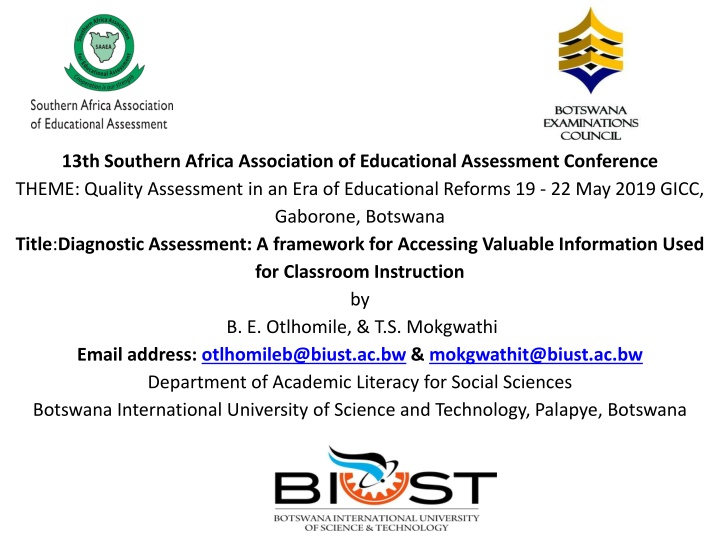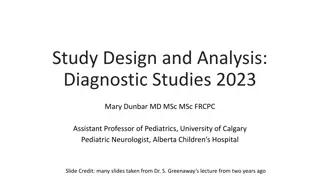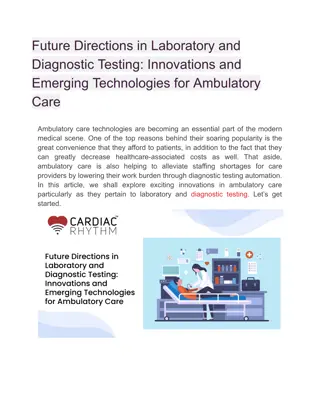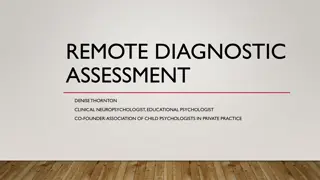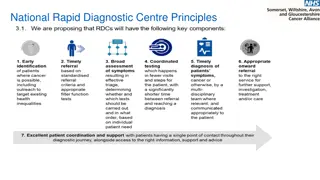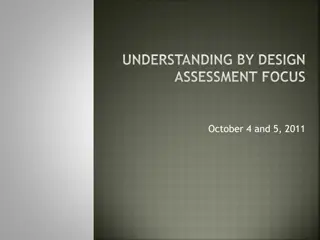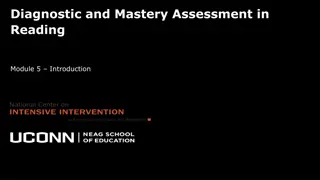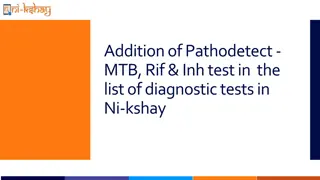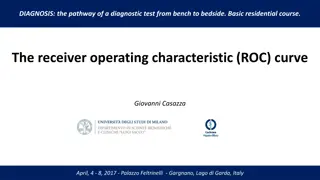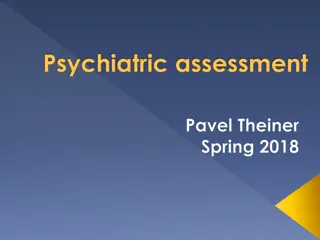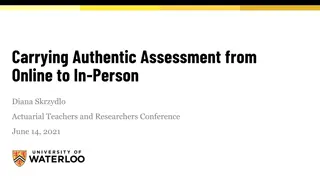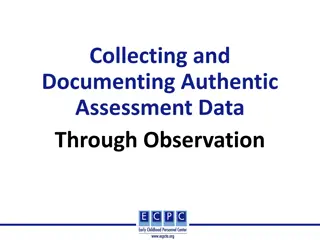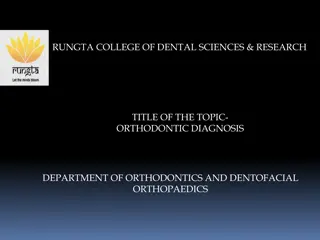Enhancing Educational Assessment Through Diagnostic Techniques
Diagnostic Assessment (DA) is a valuable technique that provides detailed information about students' knowledge and skills, supporting teachers in identifying strengths and weaknesses for tailored instruction. This approach offers a more nuanced understanding than traditional assessments, contributing to effective remedial strategies. The use of Personal Construct Theory (PCT) and tools like the Repertory Test (RT) further enhances the diagnostic capabilities of educational assessment, promoting a comprehensive view of learners' cognitive processes and individual constructs.
Download Presentation

Please find below an Image/Link to download the presentation.
The content on the website is provided AS IS for your information and personal use only. It may not be sold, licensed, or shared on other websites without obtaining consent from the author.If you encounter any issues during the download, it is possible that the publisher has removed the file from their server.
You are allowed to download the files provided on this website for personal or commercial use, subject to the condition that they are used lawfully. All files are the property of their respective owners.
The content on the website is provided AS IS for your information and personal use only. It may not be sold, licensed, or shared on other websites without obtaining consent from the author.
E N D
Presentation Transcript
13th Southern Africa Association of Educational Assessment Conference THEME: Quality Assessment in an Era of Educational Reforms 19 - 22 May 2019 GICC, Gaborone, Botswana Title:Diagnostic Assessment: A framework for Accessing Valuable Information Used for Classroom Instruction by B. E. Otlhomile, & T.S. Mokgwathi Email address: otlhomileb@biust.ac.bw & mokgwathit@biust.ac.bw Department of Academic Literacy for Social Sciences Botswana International University of Science and Technology, Palapye, Botswana
Introduction DA is an assessment technique which is designed to measure specific knowledge structures and processing skills in students ( Leighton & Gierl, 2007). DA:- helps teachers to identify strengths & weaknesses of individual learners in the target area of learning & instruction. offers more fine-grained information about learners than an overall score. is structured in a way that allows a teacher to access valuable information about the learners current state of knowledge & skills. The information can be used by the teachers & learners to come up with remedial strategies that address the learners weaknesses ( Jones, 2005)
Problem Statement Current trends in assessment discriminate among learners by putting them on a continuous uni-dimensional scale (Jang, 2008). The researchers have observed that most of the assessment techniques used by the teachers at the school are usually more distant in context from learners prior knowledge and instruction. They only report students total test scores (T-scores) which do not provide diagnostic information about learners; hence the decision by the researchers to use DA in their study. According to Jang (2005) traditional assessment procedures: lack detailed diagnostic information about learners' strengths and weaknesses, and do not provide pedagogically meaningful information to guide remedial instruction.
Theoretical Framework The Personal Construct Theory (PCT) by George Kelly (Pervin & John, 2002). PCT has been in existence for a long time, thoroughly revised and developed; it has also been effectively applied to many research fields. It uncovers tacit knowledge used by individuals. PCT posits that:- the individual is an active scientist who constantly analyses the surrounding reality, observes and looks for patterns, formulates hypotheses about the causes of events, builds theories, and makes conclusions based on gained experience. (Rogacz & Kabzi ska, 2012). Cognitive processes, such as thinking, remembering, and problem-solving play a key role in the development of personality Every person has a distinct and inimitable system of constructs.
Kelly also proposed a diagnostic tool adapted to it - The Rep Test (RT) (Role Construct Repertory Test); created as a methodological complement to the Personal Construct Theory. The RT is in the form of a structured interview which can be used to elicit personal constructs concerning a specific topic
Research Questions 1. Is CDA an effective assessment technique in assessing valuable information that can be used to help academically challenged students? 2. Can CDA be used to teach comprehension skills in a language classroom?
Methodology The data for the research were collected and analysed qualitatively. DA approach was used to extract information about the comprehension skill mastery levels of the learners. Participants The participants were 40 Form 2 (now Form 3) academically-challenged students enrolled for the Reading and Writing Lab project at a junior secondary school.
. Procedure Researchers introduced the topic and asked students to read the passage and respond to its questions. A comprehension passage with 20 questions was used to assess students reading and comprehension abilities. Topic of the passage was: The Difference Between Information & Communication Technology by Alek Kovic. The passage was run through the Coh-metrix text- readability formula to determine its suitability for the level of the students.
Task 1: Then they were instructed to answer Questions 1-10 in the first task, which was marked out of 30. Questions 1-10 were revised in class. Task 2: Students were asked to read the passage aloud in class by taking turns. (Guessing meaning from context, explaining difficult words, how to respond to wh-questions) Then students were asked to work on questions 11-20 which were marked out of 35.
Table 2: Evaluation of Diagnostic Assessment Approaches Diagnostic Assessment Approach Assessment Development Procedures Evaluation of the Assessment Approach This approach will not provide useful outcomes. The outcomes are rank numbers for each of the broad areas selected for testing, so the test provides only general information about where a student is having problems. The approach will provide useful outcomes. The item creation process is guided by a learning model. As a result, the outcomes are criterion-referenced: they describe areas where additional instruction is needed. Since the model is designed by analysing prerequisite performances, the outcomes should describe the underlying cause of reading difficulties. 1.Identify content areas to be tested. 2.Craft items that cover the basic concepts in each area. 3.Assemble the items into subtests one for each area. 4.The teacher ranks students based on the number of items they got correct. 1.Create a learning hierarchy by selecting a learning target and analysing the prerequisite performances a student must learn. 2.For each prerequisite performance, create another list of prerequisite performances until you reach prerequisites already acquired. 3.For each learning prerequisite, create items or tasks to test each performance. 4.Areas of poor test performance reveal the areas where students need additional instruction. 1.Identify final objectives to be tested. 2.Craft items that cover each objective. 3.Set a passing score for each objective. 4.The outcome is a score for each objective. 1.Identify target tasks that students should perform. 2.Identify errors made by students when performing target tasks. 3.Create target tasks. 4.Score the task by identifying errors made by students. Profiling Content Strengths and Weaknesses Identifying Prerequisite Deficits Identifying Objectives Not Mastered Testing final objectives of the Three-Year Junior Secondary Syllabus of English (CDU, 1995) would not help teachers understand the underlying causes of any reading difficulties a student might have. This approach has been well developed in the area of reading fluency in the form of miscue and self- correction analyses. These assessments would require too much training. Identifying Students Errors in Performance Adapted from: A Diagnostic Test to help Junior Secondary Teachers Plan Differentiated Reading Instruction by David P. Anderson & Gareth Dart
Results Table 1 showing marks in percentages and the number of students Rank 1 2 3 4 5 6 7 Marks in % Number of Students 94 4 93 3 86 2 80 4 60 4 50 6 22 10 Total number of Students 33
Table 2 showing marks in percentages and the number of students Rank 1 2 3 4 5 6 7 8 Marks in % 100 91 88 85 84 83 77 54 Number of Students 3 6 8 4 2 4 2 5 Total number of Students 34
Results Task 1: There was demonstration of prior knowledge Significant improvement in Task 2 Lowest mark in Task 1 was 22%, but for Task 2 it was 54% Highest mark for Task 1 was 94%, but for Task 2 it was 100%.
Results RQ 1: Is DA effective in assessing comprehension skills of academically-challenged students? YES, as demonstrated by results RQ 2: IS DA effective in assessing prior knowledge of academically-challenged students? Yes , results show that.
How we motivated students Individual attention Giving each student a chance to contribute in the learning process Annual essay-writing competition Soliciting prizes for the competition from local businesses in Palapye Our University also sponsors the competition by donating its merchandise Prizes awarded at assembly or during prize-giving ceremony
Benefits School happy with the project provides remedial for students Management noticed marked improvement in student performance concerning the subject (E L & L) Both School management & students request for more than one essay writing competition each year.
Benefits Demonstration that students' understanding & writing skills have improved Students' confidence & attitude has been boosted. Shown by the way students participate in class discussion and how they respond to questions. Some students not in the RAWL make request to join. School management requested that we share with them essays written by some of the students in the RAWL
Challenges Some students not present during tasks administration (hence 33 students out of 40 in the RAWL) RAWL conducted during study time, sometimes students are released for other school engagements Students not forewarned about task administration hence some were absent School catchment area also problematic
Conclusions Teachers seem to test post-knowledge not prior knowledge (no DA) e.g. monthly tests, end of term tests Teachers appear not to be aware of language problems their students have e.g. spelling, reading, comprehension DA is effective in assessing prior knowledge in a language class DA is effective in identifying the strengths and weaknesses that learners have.
Recommendations The teachers should familiarise themselves with DA The teachers should be trained on DA Use DA to access valuable information about learners in a language class DA should be applied to classes of other subjects There is need for collaboration between content/ subject teachers and other experts in assessment Organise workshops and short trainings on current trends in Assessment RAWL should be rolled out to other schools
